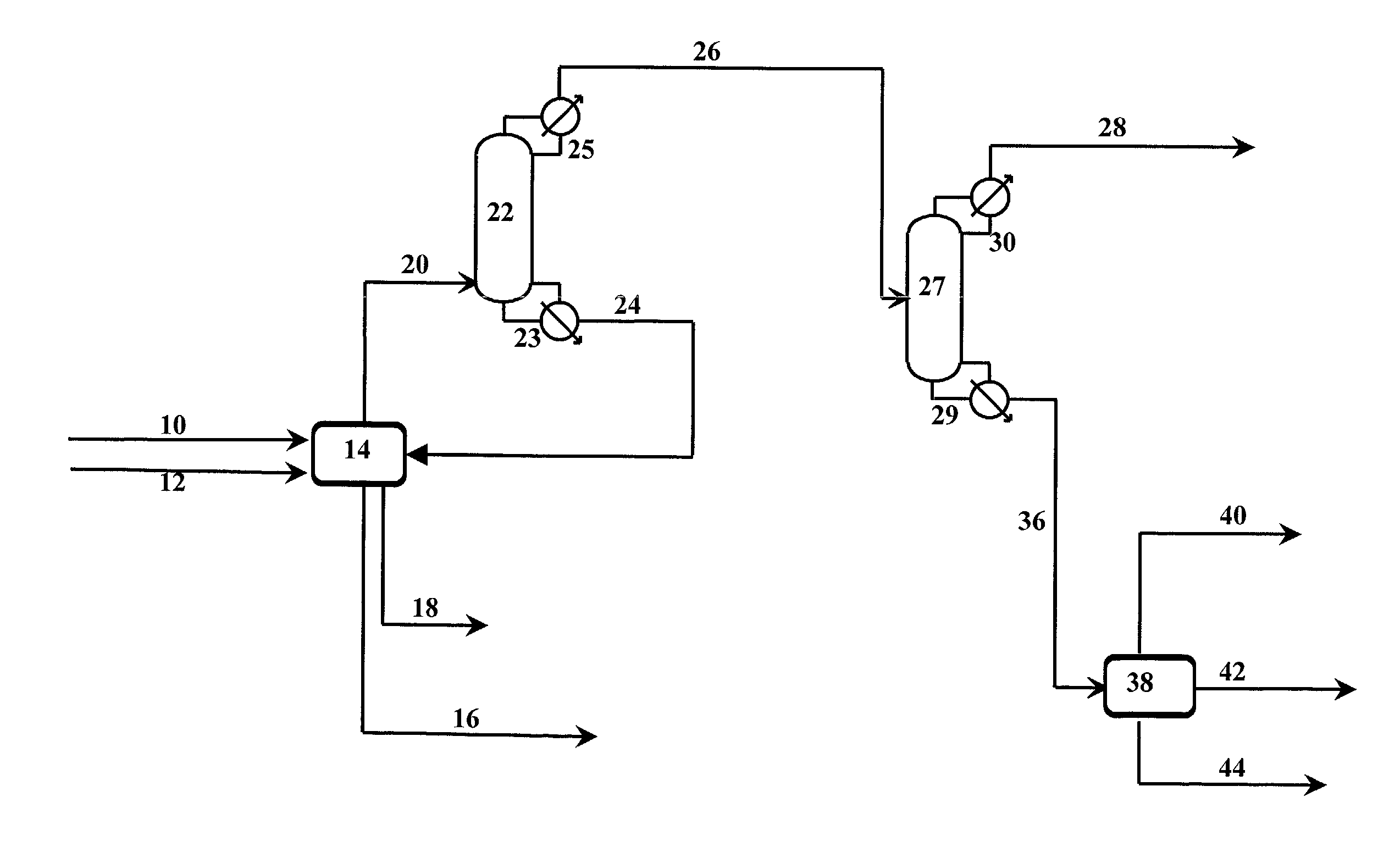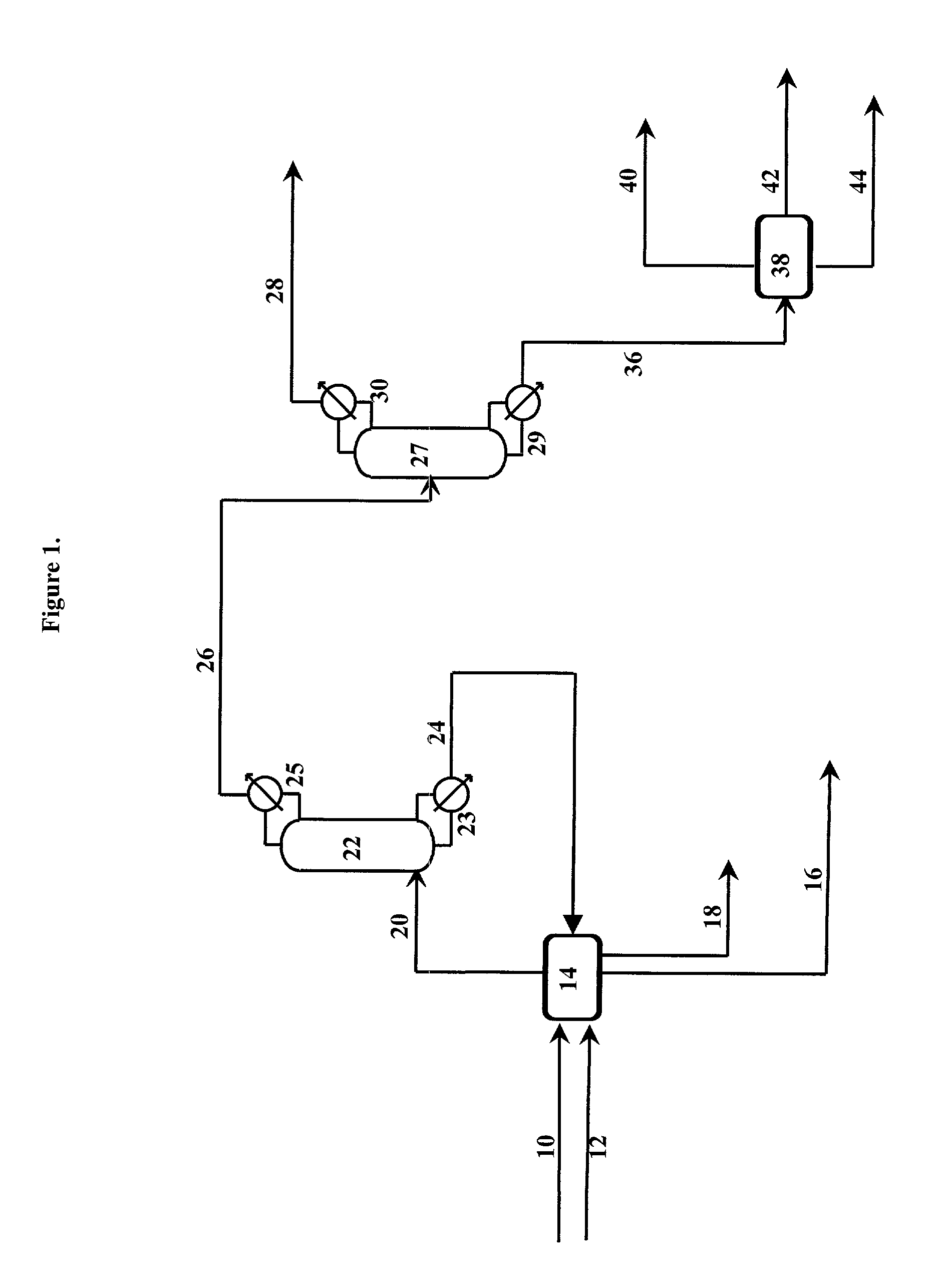Azeotropic distillation of cyclic esters of hydroxy organic acids
a technology of organic acids and cyclic esters, which is applied in the field of azeotropic distillation of cyclic esters of hydroxy organic acids, can solve the problems of affecting the downstream processing of organic acids, affecting the usefulness of preserved foods, and reducing the usefulness of lactide, so as to reduce improve the rate of formation of certain cyclic esters, and reduce the racemization of optically active species
- Summary
- Abstract
- Description
- Claims
- Application Information
AI Technical Summary
Benefits of technology
Problems solved by technology
Method used
Image
Examples
example 1
n-Dodecane Azeotropic Compositions Predicted at 191 mm Hg Based on a Group Contribution Method Estimation of Infinite Dilution Activity Coefficients which were in Turn Used to Estimate Binary NRTL (Non-Random Two Liquid) Interaction Parameters
[0072]
Temperaturedrop fromAzeotropeboiling pointboiling pointof pureSpeciesat 191 mm Hgcomponentwt %Water65.11° C.0.27° C.89.5% waterLactic Acid 135° C. 9° C. 52% Lactic acidLactide 162° C. 43° C. 19% LactideLactoyl- 164° C. 54° C. 7% Lactoyl-lactic acidlactic acidBoiling points of pure components at 191 mm HgPure Water 65.38° C.Pure Lactic Acid 144° C.Pure n-Dodecane165.68° C.Pure Lactide 205° C.Pure Lactoyl-lactic acid 218° C.
[0073]In this simulation there are four azeotropes for the n-dodecane system. It is possible to select other azeotroping agents that are heterogeneous and that favor efficient separation and recovery of lactide in preference to the other species. This involves using one or more other azeotroping agents such a...
example 2
Azeotropic Distillation of Lactide with n-Dodecane
[0074]A batch charge of 80 g n-dodecane (106.6 ml, Acros Organics catalog # 11759-5000) and 5 g crystalline meso-lactide (3,6-dimethyl-1,4-dioxane-2,5-dione, Aldrich catalog # 30,314-3) was made to a 250-mL three-neck flask, which was attached to a standard vacuum distillation system via a Claisen adapter and a 5 in Vigreaux column. Both the adapter and column had a vacuum jacket and these as well as the flask and distillation head were wrapped in extra insulation to minimize heat loss. The lactide-dodecane mixture was stirred by means of a magnetic stirrer and Teflon coated stirring bar in the flask. Heating was provided by a 250-mL heating mantle and was controlled by a variable autotransformer (power output 50%). The temperature was measured at four different points by thermocouples: liquid phase (T1), vapor phase above the liquid (T2), mid-column (T3), and column head (T4). Reduced pressure was maintained in the system by a membr...
example 3
[0077]Continuous Dodecane Vapor-Stripper Azeotropic Distillation of 50% Lactic Acid
[0078]n-Dodecane (100 g, Acros Organics catalog # 11759-5000) was placed in a 250-mL three-neck round bottom flask equipped with a magnetic stirrer and connected to a standard vacuum distillation apparatus via a 6 in column. The column was filled with Pro-Pak (Ace Glass, Inc., catalog # 6624-04) stainless steel dump-packing 5.5 inch high. The flask, column, and distillation head were well insulated against heat loss. Vacuum was provided by a membrane vacuum pump. Dodecane was heated to distill by a transformer controlled (46% power output) heating mantle. The temperature was measured by thermocouples at three different points: liquid phase (T1), vapor phase above the liquid (T2), and column head (T3). A 50% lactic acid solution containing 10 impurities to simulate a fermentation broth was continuously fed at the column head. The impurities were as follows: D-glucose (0.81 g / L), L-malic acid (0.10 g / L)...
PUM
| Property | Measurement | Unit |
|---|---|---|
| boiling point | aaaaa | aaaaa |
| boiling point | aaaaa | aaaaa |
| boiling point | aaaaa | aaaaa |
Abstract
Description
Claims
Application Information
 Login to View More
Login to View More - R&D
- Intellectual Property
- Life Sciences
- Materials
- Tech Scout
- Unparalleled Data Quality
- Higher Quality Content
- 60% Fewer Hallucinations
Browse by: Latest US Patents, China's latest patents, Technical Efficacy Thesaurus, Application Domain, Technology Topic, Popular Technical Reports.
© 2025 PatSnap. All rights reserved.Legal|Privacy policy|Modern Slavery Act Transparency Statement|Sitemap|About US| Contact US: help@patsnap.com


